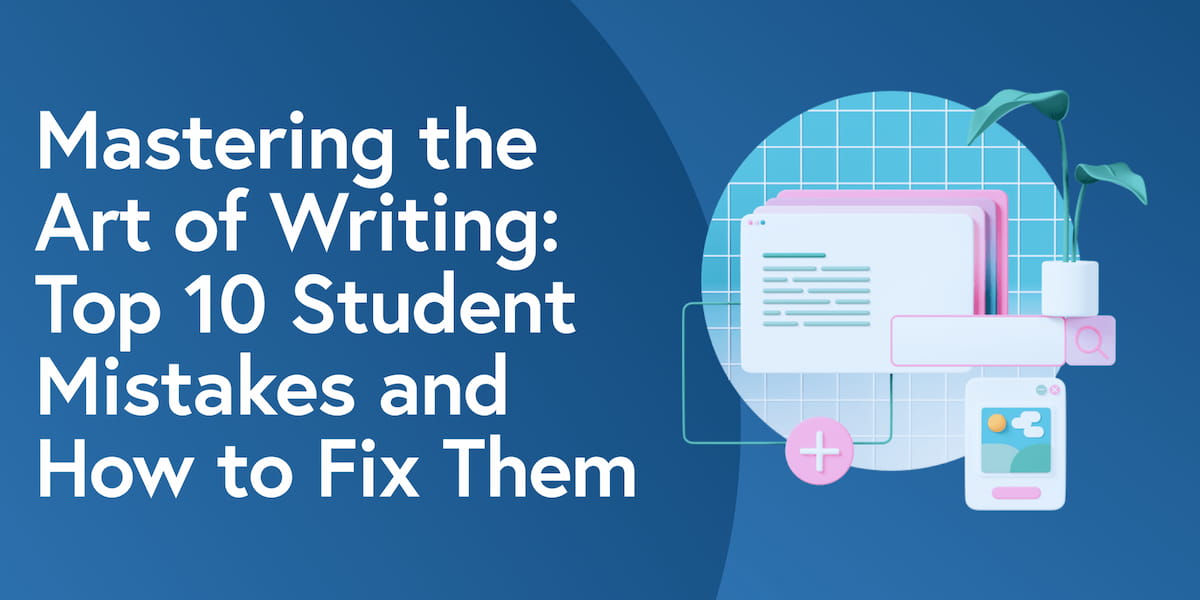
Effective writing skills are essential for students to excel in both their academic and professional lives. As middle school English/Language Arts teachers, you play a crucial role in shaping your students’ writing abilities. Understanding common writing mistakes and how to address them can greatly enhance their overall writing proficiency, so let’s explore the top ten student writing mistakes and provide some practical strategies to help middle school students overcome them.
Lack of Clarity and Focus:
Problem: Many students struggle with expressing their ideas clearly, leading to disorganized and confusing writing.
Solution: Teach students to develop a clear thesis statement that guides their writing. Encourage them to organize their thoughts using outlines or graphic organizers. Emphasize the importance of staying focused on the main idea throughout the piece. Having students simply verbalize (instead of writing) their thoughts to you at first can help get them started. Sometimes a blank page can be scary to students, and the act of putting something in writing can feel like a big commitment as well. Talking through their topic first may help them process and organize their initial thoughts more clearly.
Weak Sentence Structure:
Problem: Students often use repetitive sentence structures, resulting in monotonous and uninspiring writing.
Solution: Introduce students to various sentence types, such as simple, compound, and complex sentences. Teach them to vary their sentence structure to create more engaging and sophisticated writing. Provide examples and practice exercises to reinforce these skills. Sample texts from the authors you are currently reading would be a familiar resource for your students.
Grammar and Punctuation Errors:
Problem: Grammatical and punctuation mistakes can undermine the credibility of a student’s writing.
Solution: Regularly review essential grammar rules, including subject-verb agreement, proper verb tense usage, and correct comma placement. Engage students in grammar exercises and proofreading activities to strengthen their understanding and application of these rules. Students may be able to identify errors, but that doesn’t always mean they apply the concepts in their own writing, so be sure to have students participate in writing activities where they have to put their knowledge to use.
Spelling Mistakes:
Problem: Poor spelling can detract from the overall quality of a student’s writing.
Solution: Encourage students to develop good spelling habits by using dictionaries and word lists. Teach them mnemonic devices and spelling strategies, such as breaking words into syllables or visualizing word patterns. Regular spelling quizzes and peer editing can also help improve spelling skills. See a few sophisticated words from the current texts you’re reading? Review those words with your students!
Lack of Vocabulary Variety:
Problem: Limited vocabulary can make writing sound repetitive and monotonous.
Solution: Foster a love for reading and expose students to a wide range of literature. Encourage them to actively seek out new words and explore synonyms and antonyms. Incorporate vocabulary-building exercises and word games into the classroom routine to expand their linguistic repertoire. Remind them that diction (word choice) is an important element of developing one’s own voice, and if you haven’t read our series on Voice, there’s a great article about diction right here.
Inadequate Supporting Evidence:
Problem: Students often make claims without providing sufficient evidence to support their arguments.
Solution: Teach students to back their claims with concrete evidence, such as facts, statistics, or examples. Guide them in conducting research and teach them how to properly cite their sources. Encourage critical thinking skills by asking students to evaluate the reliability of their evidence. Try a simple activity with a simple question prompt (ie, Who has the best pizza in town?). Have your students cite specific evidence. Surely, they will all have an opinion as to why!
Weak Transitions:
Problem: Writing that lacks smooth transitions between paragraphs and ideas can appear disjointed.
Solution: Emphasize the importance of transitional words and phrases. Teach students how to use transitional expressions like “however,” “on the other hand,” or “in conclusion” to create a logical flow in their writing. Model effective transitions and provide opportunities for students to practice incorporating them into their own work. If you’d like to provide your students with a handy list of words, check out the following list of transition words and phrases!
Lack of Editing and Proofreading:
Problem: Students often submit first drafts without adequate editing and proofreading.
Solution: Teach students the importance of revising and editing their work for clarity, coherence, and correctness. Introduce them to proofreading strategies, such as reading aloud, using spell-check tools, and seeking peer feedback. Incorporate dedicated time for editing and proofreading into the writing process. Remind them that revising comes first. It’s important to “re-see” on a larger scale what they have written, so if any wholesale changes need to be made, they haven’t wasted their time editing (correcting punctuation and grammar issues).
Ignoring Audience and Purpose:
Problem: Students sometimes fail to consider their intended audience and purpose when writing.
Solution: Discuss the importance of tailoring writing to specific audiences and purposes. Teach students to adjust their tone, language, and style accordingly. Provide writing prompts that require students to consider their audience and purpose explicitly. Need a refresher on the importance of audience in writing? See our blog article here!
Lack of Revision:
Problem: Students often view writing as a one-time task, neglecting the revision process.
Solution: Teach students the value of revision as an essential part of the writing process. Show them how revising can strengthen their arguments, improve organization, and enhance clarity. Teach them specific revision techniques, such as adding or removing details, reordering paragraphs, or rewriting sentences. Always require a first and second draft as checkpoints along the way, and students will begin the see the value when their writing improves from one draft to the next.
By addressing these top ten writing mistakes and implementing effective strategies to overcome them, you can empower your students to become confident and proficient writers. Remember, patience and consistent practice are key to developing strong writing skills, and with your guidance, students will be equipped to express themselves eloquently and effectively in any writing task that comes their way.
Read More

English Grammar 101 Alternatives

When You Ask for Analysis but You Get Summary Instead

Establishing Confident Writers Through Creativity and Self-Expression

Brainstorming Through Writer’s Block

Four Steps to Teaching Your Students Adverbs

How to Fire Your Internal Critic

What Just 10 Minutes of Daily Journaling Can Do for Student Writing



